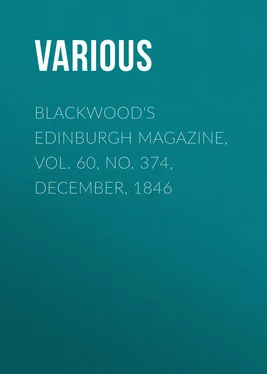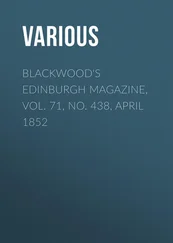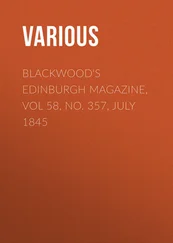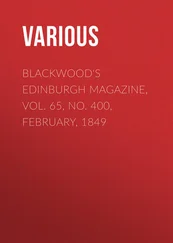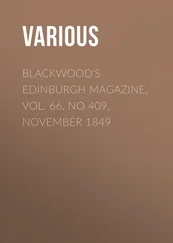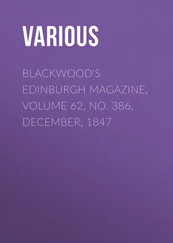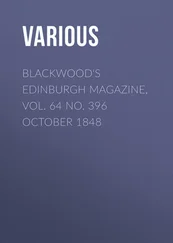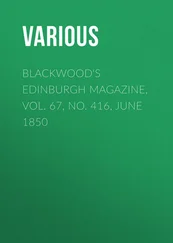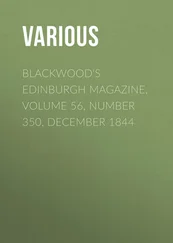Various - Blackwood's Edinburgh Magazine, Vol. 60, No. 374, December, 1846
Здесь есть возможность читать онлайн «Various - Blackwood's Edinburgh Magazine, Vol. 60, No. 374, December, 1846» — ознакомительный отрывок электронной книги совершенно бесплатно, а после прочтения отрывка купить полную версию. В некоторых случаях можно слушать аудио, скачать через торрент в формате fb2 и присутствует краткое содержание. Издательство: Иностранный паблик, Жанр: periodic, foreign_edu, Путешествия и география, на английском языке. Описание произведения, (предисловие) а так же отзывы посетителей доступны на портале библиотеки ЛибКат.
- Название:Blackwood's Edinburgh Magazine, Vol. 60, No. 374, December, 1846
- Автор:
- Издательство:Иностранный паблик
- Жанр:
- Год:неизвестен
- ISBN:нет данных
- Рейтинг книги:4 / 5. Голосов: 1
-
Избранное:Добавить в избранное
- Отзывы:
-
Ваша оценка:
- 80
- 1
- 2
- 3
- 4
- 5
Blackwood's Edinburgh Magazine, Vol. 60, No. 374, December, 1846: краткое содержание, описание и аннотация
Предлагаем к чтению аннотацию, описание, краткое содержание или предисловие (зависит от того, что написал сам автор книги «Blackwood's Edinburgh Magazine, Vol. 60, No. 374, December, 1846»). Если вы не нашли необходимую информацию о книге — напишите в комментариях, мы постараемся отыскать её.
Blackwood's Edinburgh Magazine, Vol. 60, No. 374, December, 1846 — читать онлайн ознакомительный отрывок
Ниже представлен текст книги, разбитый по страницам. Система сохранения места последней прочитанной страницы, позволяет с удобством читать онлайн бесплатно книгу «Blackwood's Edinburgh Magazine, Vol. 60, No. 374, December, 1846», без необходимости каждый раз заново искать на чём Вы остановились. Поставьте закладку, и сможете в любой момент перейти на страницу, на которой закончили чтение.
Интервал:
Закладка:
In his present volumes, Mr Kohl refers only passingly to the subject of education in Denmark. He remarks that the national schools far surpassed his expectations. He might have said more. For the last thirty or forty years, we believe, it has been rare to meet with the commonest peasant who could not read and write; a fact proving, at least, that Denmark is rather in advance than otherwise of her richer neighbours in carrying out the educational measures which, of late years, have so largely occupied the attention of the various governments of Europe. No one in Denmark can enter the army or navy who has not previously received his education at one or other of the military academies of the country. The course of study is well arranged. It embraces, besides the classics, modern languages, drawing, and exercises both equestrian and gymnastic. The academies themselves are under the immediate direction of the best military and naval officers in the service. For the education of the people, two or three schools are provided in every village, the masters receiving a small salary, with a house and certain perquisites. In 1822 the system of Bell was introduced in the elementary public schools, and since that period it has been generally adhered to.
Our author speaks with natural surprise of the small number of Roman Catholics he encountered in the Danish States. The Papists have no church or chapel throughout the kingdom; indeed, with the exception of the private chapel of the Austrian minister, no place of worship. We were aware that such was the fact a few years ago; we were scarcely prepared to find that Rome, who has been so busy in planting new shoots of her faith in every nook of the known world, is still content to have no recognition in Denmark. Heavy penalties are incurred by all who secede to the Romish church. In Sweden a change to Roman Catholicism is followed by banishment. This severity, we presume, must be ascribed to state policy rather than to a spirit of intolerance, for Jews and Christians of every denomination are permitted the freest exercise of their faith. Since the year 1521, the era of the Reformation in Denmark, the religion of the country has been Lutheran. The Danish church is divided into five dioceses, of which the bishop of Zealand is the metropolitan. His income is about a thousand a-year, whilst that of the other prelates varies from four to six hundred. The funds of the clergy are derived principally from tithes; but the parish ministers receive part of their stipend in the form of offerings at the three great annual festivals. Until lately, there existed much lukewarmness on all religious questions. Within the last ten or fifteen years, however, a new impulse has been given to the spiritual mind by the writing and preaching of several Calvinistic ministers, who have migrated from Switzerland and established themselves in Copenhagen. Their object has been to stop the recreations which, until their arrival, enlivened the Sabbath-day. They have met with more success in the higher classes than amongst the people, who now, as formerly, assemble on the green in front of the village church at the close of service, and pursue their several pastimes.
Mention is made in Mr Kohl's volume, of the churchyards and cemetries he visited in his hasty progress. Compared with those of his own northern Germany, the Scandinavian places of burial are indeed very beautiful. The government has long since forbidden any new interments to be made within the churches, and many picturesque spots have, in consequence, been converted into cemetries. In the immediate vicinity of Copenhagen there are several; but the essence of Mr Kohl's plan being want of arrangement, he makes no mention of them for the present. One of these cemetries, the Assistenskirkegaard , outside the city, has an unusual number of fine monuments, with no exhibitions of that glaring want of taste so frequently met with elsewhere. The village churchyards are bright, happy-looking spots, which, by their cheerful aspect, seem to rob the homes of the dead of all their natural gloom and desolation. Every peasant's grave is a bed of flowers, planted, watched, and cherished by a sorrowing friend. At either end of the seven or eight feet of mound rises a wooden cross, on which fresh wreaths of flowers appear throughout the summer, giving place only to the "eternals" which adorn the grave when snow mantles its surface. A narrow walk, marked by a line of box, incloses every mound; or, not unfrequently, a trellis-work, tastefully entwined of twigs and boughs. The resting-places of the middle classes are surmounted by a tablet, not, as in our churchyards, rigidly inclosed within impassable palisades, but standing in a little garden, where the fresh-blown flowers, the neatly trimmed beds, and generally the garden-bench, mark that the spot is visited and tended by the friends of those who sleep below. Hither widowed mothers lead their children, on the anniversary of their father's death, to strew flowers on his grave, to hang up the wreaths which they have wound; but, above all, to collect the choicest flowers that have bloomed around him, which must henceforth deck, until they perish, the portrait of the departed, or some relic dear for his sake. We have watched the rough work-worn peasant, leading by the hand his little grandchild, laden with flowers and green twigs to freshen the grave of a long-absent helpmate; and as we have remarked, we confess not without emotion, feeble infancy and feeble age uniting their weak efforts to preserve, in cleanliness and beauty, the one sacred patch of earth – we have believed, undoubtingly, that whilst customs such as these prevail, happiness and morality must be the people's lot; and that very fearful must be the responsibility of those who shall sow the first seeds of discord and dissension amongst the simple peasantry of so fair a land!
The cathedrals of Denmark are of great antiquity. Those of Ribe, of Viboig in Jutland, of Lard, Ringsted, and Roeskilde, in Zealand, all date from the end of the eleventh, or the beginning of the twelfth century; since which remote period, in fact, no churches of any magnitude have been erected. Roeskilde is one of the oldest cities in the kingdom. In the tenth century it was the capital. Canute the Great may be considered as the originator and founder of its existing cathedral, which was completed in the year 1054. It has occasionally undergone slight repairs, but never any material alteration. The edifice is full of monuments of the queens and kings of the ancient race of Valdemar, as well as of those of the present dynasty. Some of the earliest sovereigns are inclosed within the shafts of the pillars, or in the walls themselves; a mode of sepulture, it would appear, as honourable as it is singular, since we find amongst the immured the great Svend Etridsen , and other renowned and pious benefactors of the church. In front of the altar is the simple sarcophagus of Margaret, the great queen of Scandinavia, erected by her successor, Eric the Pomeranian. The queen is represented lying at full length, with her hands devoutly folded on her breast. At this sarcophagus our author lingers for a moment to express sentiments which would have brought down upon him the anathemas of the good John Knox, could that pious queen-hater but have heard them. Mr Kohl defies you to produce, from the number of royal ladies who have held supreme power in the world, one instance of inadequacy and feebleness. Every where, he insists, examples of female nobility and strength of character are found linked with the destinies of kings who have earned for themselves no better titles than those of the fainéant and the simple. The style of Roeskilde cathedral is pure Gothic; but in consequence of the additions which the interior has received from time to time from kings and prelates, that portion of the edifice is more remarkable for historical interest than for purity of style or architectural beauty. One incident in connexion with this building must not be omitted. When Mr Kohl quitted the cathedral, he offered his cicerone a gratuity. The man respectfully declined accepting even the customary fees. The reason being asked of a Danish gentleman, the latter answered, that the man was a patriot, and proud of the historical monuments of his country; it would be degradation to take reward from a stranger who seemed so deeply interested in them. One would almost suspect that this honest fellow was a verger of Westminster Abbey !
Читать дальшеИнтервал:
Закладка:
Похожие книги на «Blackwood's Edinburgh Magazine, Vol. 60, No. 374, December, 1846»
Представляем Вашему вниманию похожие книги на «Blackwood's Edinburgh Magazine, Vol. 60, No. 374, December, 1846» списком для выбора. Мы отобрали схожую по названию и смыслу литературу в надежде предоставить читателям больше вариантов отыскать новые, интересные, ещё непрочитанные произведения.
Обсуждение, отзывы о книге «Blackwood's Edinburgh Magazine, Vol. 60, No. 374, December, 1846» и просто собственные мнения читателей. Оставьте ваши комментарии, напишите, что Вы думаете о произведении, его смысле или главных героях. Укажите что конкретно понравилось, а что нет, и почему Вы так считаете.
